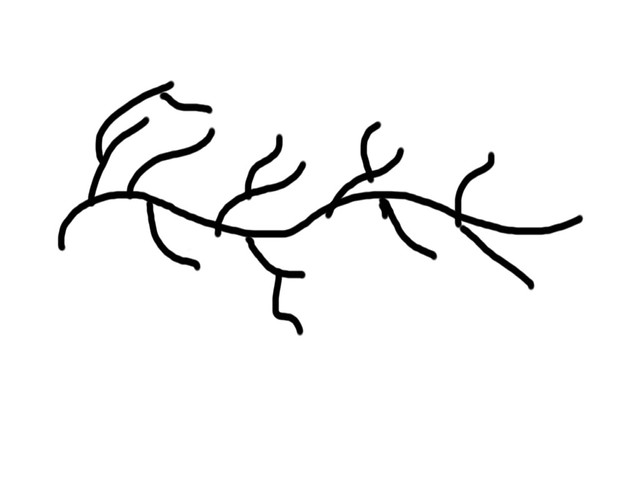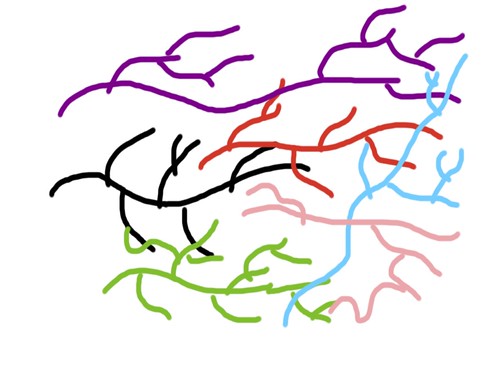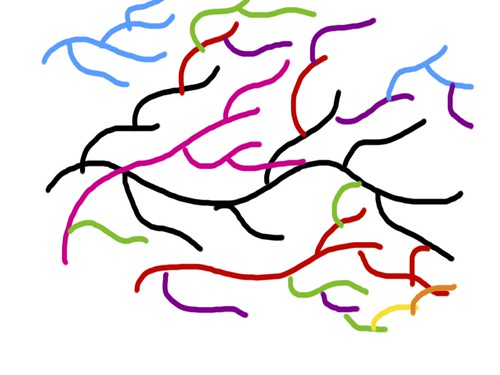Attack of the untext - my own stumbling blocks
It's been a while since Rhizo14 ended, but the community is going strong! Facebook may not be as active (or maybe facebook is hiding most Rhizo posts from my timeline...that could be it...anyway), but we are still chugging along with the collaborative *graphy. I can't call it an ethnography, or autoethnography because variables have changed. Some of us decided to get together and write an article for Hybrid Pedagogy on why the Collaborative *graphy article is taking so long (a meta-article if you will) but we got stuck there too (or it seems as though we are stuck). I think others have written about their own personal views on this on their own blogs, so I've been working out what my own stumbling blocks are with this project. I think I have a way to explain things now!
So, when working collaboratively in previous collaborative work situations your final product feel unified. The main analogy that I can give give is the main root of one plant which looks like this:
So, when working collaboratively in previous collaborative work situations your final product feel unified. The main analogy that I can give give is the main root of one plant which looks like this:
In this example (going with the rhizome metaphor) you have one main path, and all the side paths are footnotes, citations and references, and end-note commentary. The coloring is all the same because regardless of where you have one author or many authors the final product sounds like a unified voice. Many ideas have come into, and go out of, this main line (see expansion roots in the model), but at the end of the day those side roots don't overtake the main idea or argument.
The original project started as a collaborative autoethnography (CollabAE). This eventually became an issue because some people stepped back from the project and thus is was no longer an autoethnography for the entire MOOC, but rather an multi-author ethnography (MAE) of the MOOC. We could use other people's anonimized data, assuming that we had their permission. At that point it wasn't introspective (auto-ethnography) but rather analytic - but this seemed to lack the rhizomatic aspect (to some extent anyway) that made the CAE unique in this aspect, and there were issues of silencing voices (or inadvertantly silencing voices since some people didn't want to be authors, or weren't comfortable with their views being part of this analysis). Things got busy with school, work, and others pursuits that I lost track of the CAE.
The CAE, at least the way we collected data, looks like the image above. Each color represents a different author, and each other has (probably) a main point and certain supporting literature, tangents, side-points and so on that they made in their original write up. Some authors connect to other author's writings, and this is visualized above as roots crossing through other root's paths. As chaotic as this may look, it does make sense. I think the closest analogy for this would be George Veletsiano's Student Experiences of MOOCs eBook. To some extend (being a bunch of experimental academics ;-) ) we may have over-thought this CAE. In hindsight, I would say that this should be a multi-step process. Perhaps the first step in the process, with a deliverable, would be an eBook, similar to Veletsiano's style, of our Rhizo experiences. Here people can write anonymously or eponymously. Submitted chapters could go through peer review, but not the traditional academic peer review - the peer review that aims to disambiguate and seeks to grow those side-roots a bit in case eventual readers want to do down the paths. There could be a foreword (Dave Cormier perhaps?) but the reader would be left to read, process, and make sense of each individual story. As such this could be not a collaborative AE but a cooperative AE (CoopAE), people working concurrently, but not necessarily together to get this done. One big, overall, document, but each chapter can stand on its own.
So since the CollabAE wasn't going far, a couple of people thought we could sit down and write an article about what's up with this process. Why are things taking so long? The visual for this untext looks something like this (according to me anyway).
Whereas the CollabAE has separate, but distinct, stories where others commented on, but didn't necessarily write-over the text, in our meta-analysis I am seeing both original (concurrent) threads emerging (two or more people writing at the same time but not about the same message). This is represented by different color main-roots. Then I am also seeing people expanding on those main-roots (different color sub-roots) by either adding onto the document, or having side conversations. I have to admit that this is fascinating as a brainstorming piece, and it could be considered by some as a performance piece or something alternative like #remixthediss.
That said, however, the problem is that we don't have an audience. A document as chaotic as this one is helpful to us as authors to help us better understand our own positions on things, and to better help us understand or analyze our own lived experiences in the MOOC. However, I am not convinced that this is geared toward a reading audience. It's not necessarily something that they expect, and I am not sure how a reader will process this chaos. For me, at the end of the day, I go back to my goal. What is the goal of the *graphy project (decided to change it's name since CollabAE and CoopAE seem to not describe it)? What is the goal of the untext about the *graphy project? Is the goal something for the internal constituents? Something for the public? If it's for both, what's the overlap space where the final published product would be useful (and comprehensible) to both? Good questions. I've got my own answers, but as a group...I don't know :)
As a side note, this seems like an interesting application of co-learning (see connected courses for more details)





Comments